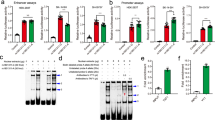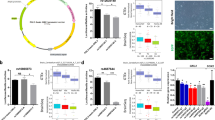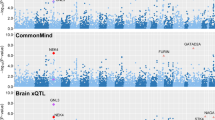Abstract
Genome-wide association studies (GWASs) have reported many single nucleotide polymorphisms (SNPs) associated with psychiatric disorders, but knowledge is lacking regarding molecular mechanisms. Here we show that risk alleles spanning multiple genes across the 10q24.32 schizophrenia-related locus are associated in the human brain selectively with an increase in the expression of both BLOC-1 related complex subunit 7 (BORCS7) and a previously uncharacterized, human-specific arsenite methyltransferase (AS3MT) isoform (AS3MTd2d3), which lacks arsenite methyltransferase activity and is more abundant in individuals with schizophrenia than in controls. Conditional-expression analysis suggests that BORCS7 and AS3MTd2d3 signals are largely independent. GWAS risk SNPs across this region are linked with a variable number tandem repeat (VNTR) polymorphism in the first exon of AS3MT that is associated with the expression of AS3MTd2d3 in samples from both Caucasians and African Americans. The VNTR genotype predicts promoter activity in luciferase assays, as well as DNA methylation within the AS3MT gene. Both AS3MTd2d3 and BORCS7 are expressed in adult human neurons and astrocytes, and they are upregulated during human stem cell differentiation toward neuronal fates. Our results provide a molecular explanation for the prominent 10q24.32 locus association, including a novel and evolutionarily recent protein that is involved in early brain development and confers risk for psychiatric illness.
This is a preview of subscription content, access via your institution
Access options
Subscribe to this journal
Receive 12 print issues and online access
$209.00 per year
only $17.42 per issue
Buy this article
- Purchase on Springer Link
- Instant access to full article PDF
Prices may be subject to local taxes which are calculated during checkout





Similar content being viewed by others

References
Prince, M. et al. No health without mental health. Lancet 370, 859–877 (2007).
O'Donovan, M.C. et al. Identification of loci associated with schizophrenia by genome-wide association and follow-up. Nat. Genet. 40, 1053–1055 (2008).
Stefansson, H. et al. Common variants conferring risk of schizophrenia. Nature 460, 744–747 (2009).
Schizophrenia Working Group of the Psychiatric Genomics Consortium. Biological insights from 108 schizophrenia-associated genetic loci. Nature 511, 421–427 (2014).
Psychiatric GWAS Consortium Bipolar Disorder Working Group. Large-scale genome-wide association analysis of bipolar disorder identifies a new susceptibility locus near ODZ4. Nat. Genet. 43, 977–983 (2011).
Ripke, S. et al. Genome-wide association analysis identifies 13 new risk loci for schizophrenia. Nat. Genet. 45, 1150–1159 (2013).
Cross-Disorder Group of the Psychiatric Genomics Consortium. Identification of risk loci with shared effects on five major psychiatric disorders: a genome-wide analysis. Lancet 381, 1371–1379 (2013).
Shi, J. et al. Common variants on chromosome 6p22.1 are associated with schizophrenia. Nature 460, 753–757 (2009).
Shi, Y. et al. Common variants on 8p12 and 1q24.2 confer risk of schizophrenia. Nat. Genet. 43, 1224–1227 (2011).
Rietschel, M. et al. Association between genetic variation in a region on chromosome 11 and schizophrenia in large samples from Europe. Mol. Psychiatry 17, 906–917 (2012).
Ripke, S. et al. Genome-wide association study identifies five new schizophrenia loci. Nat. Genet. 43, 969–976 (2011).
Huffaker, S.J. et al. A primate-specific, brain isoform of KCNH2 affects cortical physiology, cognition, neuronal repolarization and risk of schizophrenia. Nat. Med. 15, 509–518 (2009).
Tao, R. et al. Expression of ZNF804A in human brain and alterations in schizophrenia, bipolar disorder, and major depressive disorder: a novel transcript fetally regulated by the psychosis risk variant rs1344706. JAMA Psychiatry 71, 1112–1120 (2014).
Law, A.J. et al. Neuregulin 1 transcripts are differentially expressed in schizophrenia and regulated by 5′ SNPs associated with the disease. Proc. Natl. Acad. Sci. USA 103, 6747–6752 (2006).
Wedenoja, J. et al. Replication of association between working memory and Reelin, a potential modifier gene in schizophrenia. Biol. Psychiatry 67, 983–991 (2010).
Zhang, J. et al. A cis-phase interaction study of genetic variants within the MAOA gene in major depressive disorder. Biol. Psychiatry 68, 795–800 (2010).
Prata, D.P. et al. Altered effect of dopamine transporter 3′UTR VNTR genotype on prefrontal and striatal function in schizophrenia. Arch. Gen. Psychiatry 66, 1162–1172 (2009).
Wood, T.C. et al. Human arsenic methyltransferase (AS3MT) pharmacogenetics: gene resequencing and functional genomics studies. J. Biol. Chem. 281, 7364–7373 (2006).
Valluy, J. et al. A coding-independent function of an alternative Ube3a transcript during neuronal development. Nat. Neurosci. 18, 666–673 (2015).
Pu, J. et al. BORC, a multisubunit complex that regulates lysosome positioning. Dev. Cell 33, 176–188 (2015).
Lonsdale, J. et al. & GTEx Consortium. The genotype-tissue expression (GTEx) project. Nat. Genet. 45, 580–585 (2013).
Harrison, P.J. The hippocampus in schizophrenia: a review of the neuropathological evidence and its pathophysiological implications. Psychopharmacology (Berl.) 174, 151–162 (2004).
Oberdoerffer, S. A conserved role for intragenic DNA methylation in alternative pre-mRNA splicing. Transcription 3, 106–109 (2012).
Jaffe, A.E. et al. Mapping DNA methylation across development, genotype and schizophrenia in the human frontal cortex. Nat. Neurosci. 19, 40–47 (2016).
Geng, Z. et al. Effects of selenium on the structure and function of recombinant human S-adenosyl-L-methionine dependent arsenic (+3 oxidation state) methyltransferase in E. coli. J. Biol. Inorg. Chem. 14, 485–496 (2009).
Antonelli, R., Shao, K., Thomas, D.J., Sams, R. II & Cowden, J. AS3MT, GSTO, and PNP polymorphisms: impact on arsenic methylation and implications for disease susceptibility. Environ. Res. 132, 156–167 (2014).
Rodrigues, E.G. et al. GSTO and AS3MT genetic polymorphisms and differences in urinary arsenic concentrations among residents in Bangladesh. Biomarkers 17, 240–247 (2012).
Agusa, T., Fujihara, J., Takeshita, H. & Iwata, H. Individual variations in inorganic arsenic metabolism associated with AS3MT genetic polymorphisms. Int. J. Mol. Sci. 12, 2351–2382 (2011).
Lin, S. et al. A novel S-adenosyl-L-methionine:arsenic(III) methyltransferase from rat liver cytosol. J. Biol. Chem. 277, 10795–10803 (2002).
Tyler, C.R. & Allan, A.M. The effects of arsenic exposure on neurological and cognitive dysfunction in human and rodent studies: a review. Curr. Environ. Health Rep. 1, 132–147 (2014).
Ghiani, C.A. et al. The dysbindin-containing complex (BLOC-1) in brain: developmental regulation, interaction with SNARE proteins and role in neurite outgrowth. Mol. Psychiatry 15, 204–215 (2010).
Morris, D.W. et al. Dysbindin (DTNBP1) and the biogenesis of lysosome-related organelles complex 1 (BLOC-1): main and epistatic gene effects are potential contributors to schizophrenia susceptibility. Biol. Psychiatry 63, 24–31 (2008).
Jaffe, A.E. et al. Developmental regulation of human cortex transcription and its clinical relevance at single base resolution. Nat. Neurosci. 18, 154–161 (2015).
Kunii, Y. et al. Revisiting DARPP-32 in postmortem human brain: changes in schizophrenia and bipolar disorder and genetic associations with t-DARPP-32 expression. Mol. Psychiatry 19, 192–199 (2014).
Lipska, B.K. et al. Critical factors in gene expression in postmortem human brain: Focus on studies in schizophrenia. Biol. Psychiatry 60, 650–658 (2006).
Trapnell, C., Pachter, L. & Salzberg, S.L. TopHat: discovering splice junctions with RNA-Seq. Bioinformatics 25, 1105–1111 (2009).
Liao, Y., Smyth, G.K. & Shi, W. featureCounts: an efficient general purpose program for assigning sequence reads to genomic features. Bioinformatics 30, 923–930 (2014).
Scharpf, R.B., Irizarry, R.A., Ritchie, M.E., Carvalho, B. & Ruczinski, I. Using the R Package crlmm for Genotyping and Copy Number Estimation. J. Stat. Softw. 40, 1–32 (2011).
Ioannidis, J.P., Ntzani, E.E., Trikalinos, T.A. & Contopoulos-Ioannidis, D.G. Replication validity of genetic association studies. Nat. Genet. 29, 306–309 (2001).
Acknowledgements
We thank A. Deep-Soboslay (Lieber Institute for Brain Development) for her tireless efforts in clinical diagnosis and demographic characterization; R. Zielke, R.D. Vigorito and R.M. Johnson (National Institute of Child Health and Human Development Brain and Tissue Bank for Developmental Disorders at the University of Maryland) for their provision of fetal, pediatric and adolescent brain tissue specimens; X. Xiao (Johns Hopkins Bloomberg School of Public Health) for her technical assistance. This work was supported by funding from the Lieber Institute for Brain Development and the Maltz Research Laboratories, and from a Senior Investigator grant from the Brain Behavior Research Foundation (J.E.K.). The Genotype-Tissue Expression (GTEx) Project was supported by the Common Fund of the Office of the Director of the US National Institutes of Health. Additional funds were provided by the NCI, NHGRI, NHLBI, NIDA, NIMH and the NINDS. Donors were enrolled at Biospecimen Source Sites funded by NCI\SAIC-Frederick, Inc. (SAIC-F) subcontracts to the National Disease Research Interchange (10XS170), Roswell Park Cancer Institute (10XS171) and Science Care, Inc. (X10S172). The Laboratory, Data Analysis and Coordinating Center (LDACC) were funded through a contract (HHSN268201000029C) to the Broad Institute, Inc. Biorepository operations were funded through an SAIC-F subcontract to Van Andel Institute (10ST1035). Additional data repository and project management were provided by SAIC-F (HHSN261200800001E). The Brain Bank was supported by supplements to University of Miami grants DA006227 & DA033684, and to contract N01MH000028. Statistical Methods development grants were made to the University of Geneva (MH090941 & MH101814), the University of Chicago (MH090951, MH090937, MH101820, MH101825), the University of North Carolina at Chapel Hill (MH090936 & MH101819), Harvard University (MH090948), Stanford University (MH101782), Washington University St. Louis (MH101810) and the University of Pennsylvania (MH101822). The data used for the analyses described in this manuscript were obtained from dbGaP accession number phs000424.v6.p1 on October 6, 2015. Data were generated as part of the CommonMind Consortium supported by funding from Takeda Pharmaceuticals Company Limited, F. Hoffman-La Roche, Ltd. and NIH grants R01MH085542, R01MH093725, P50MH066392, P50MH080405, R01MH097276, RO1-MH-075916, P50M096891, P50MH084053S1, R37MH057881 and R37MH057881S1, HHSN271201300031C, AG02219, AG05138 and MH06692. Brain tissue for the study was obtained from the following brain-bank collections: the Mount Sinai NIH Brain and Tissue Repository, the University of Pennsylvania Alzheimer's Disease Core Center, the University of Pittsburgh NeuroBioBank and Brain and Tissue Repositories and the NIMH Human Brain Collection Core. CMC Leadership: P. Sklar, J. Buxbaum (Icahn School of Medicine at Mount Sinai), B. Devlin, D. Lewis (University of Pittsburgh), R. Gur, C.-G. Hahn (University of Pennsylvania), K. Hirai, H. Toyoshiba (Takeda Pharmaceuticals Company, Ltd.), E. Domenici, L. Essioux (F. Hoffman-La Roche, Ltd.), L. Mangravite, M. Peters (Sage Bionetworks), T. Lehner, B. Lipska (NIMH).
Author information
Authors and Affiliations
Contributions
M.L. and D.R.W. designed the study and interpreted the results. M.L., A.E.J., R.T., J.H.S., C.L., Y.J., K.O. and R.E.S. carried out RNA-seq analysis. T.M.H. and J.E.K. organized and carried out subject recruitment, phenotype analysis and biological-material collection. M.L., Q.C. and A.E.J. performed genotyping and imputation. M.L. conducted in vitro functional assays, molecular cloning, cell line experiments, western blot, immunofluorescence and preparation of recombinant proteins, and M.L. and D.R.W. analyzed those data. M.L., R.T. and C.L. performed RT-qPCR. B.J.M., D.J.H., N.J.B. and A.C. contributed to design and analysis of protein-expression experiments. M.L., Y.W., J.G.C. and R.M. performed the iPSC experiments. H.W. carried out enzymatic assay analysis. M.L. and D.R.W. drafted the manuscript, and all authors contributed to the final version of the paper.
Corresponding author
Ethics declarations
Competing interests
The authors declare no competing financial interests.
Supplementary information
Supplementary Text and Figures
Supplementary Figures 1–15 and Supplementary Tables 1–13 (PDF 4154 kb)
Supplementary Dataset 1
Demographic characteristics of individuals in RNA-sequencing and the paths to RNA-sequencing .bam file and expression metrics (CSV 372 kb)
Rights and permissions
About this article
Cite this article
Li, M., Jaffe, A., Straub, R. et al. A human-specific AS3MT isoform and BORCS7 are molecular risk factors in the 10q24.32 schizophrenia-associated locus. Nat Med 22, 649–656 (2016). https://doi.org/10.1038/nm.4096
Received:
Accepted:
Published:
Issue Date:
DOI: https://doi.org/10.1038/nm.4096
This article is cited by
-
Identification of a psychiatric risk gene NISCH at 3p21.1 GWAS locus mediating dendritic spine morphogenesis and cognitive function
BMC Medicine (2023)
-
Rediscovering tandem repeat variation in schizophrenia: challenges and opportunities
Translational Psychiatry (2023)
-
Integrative analyses highlight functional regulatory variants associated with neuropsychiatric diseases
Nature Genetics (2023)
-
Transcriptomic underpinnings of high and low mirror aggression zebrafish behaviours
BMC Biology (2022)
-
Comprehensive and integrative analyses identify TYW5 as a schizophrenia risk gene
BMC Medicine (2022)


